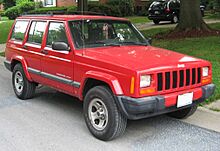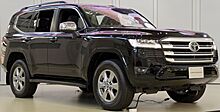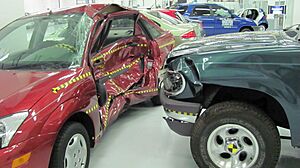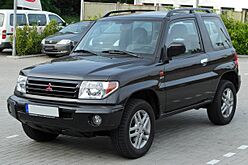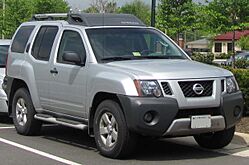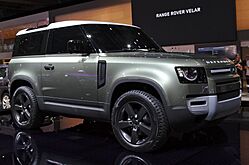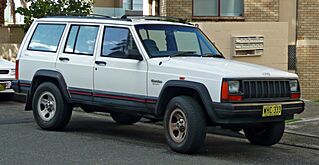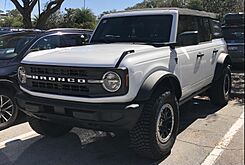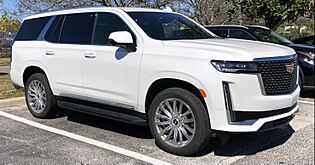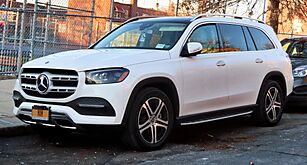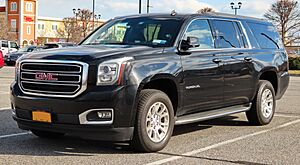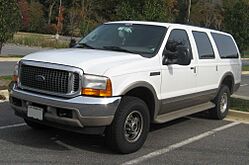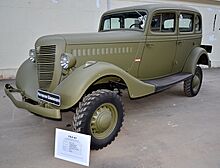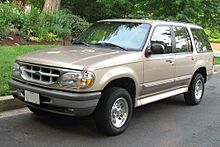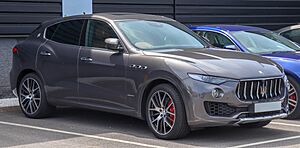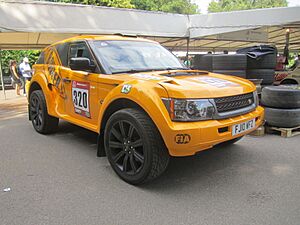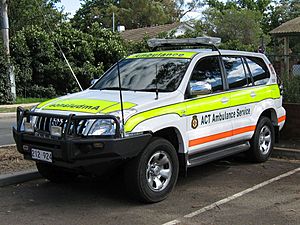Sport utility vehicle facts for kids
A Sport Utility Vehicle (often called an SUV) is a type of car that mixes features from regular passenger cars with features from off-road vehicles. Think of it as a car that can handle both smooth roads and rougher paths! SUVs usually have a higher ride height and sometimes come with four-wheel drive, which helps them drive on different types of ground.
There isn't one perfect definition for an SUV, and what people call an SUV can be different in various countries. Generally, it's a vehicle with four-wheel drive that can do a bit of everything. Some people say an SUV must be built like a truck, but others include any vehicle that looks like it can go off-road. A crossover SUV is a type of SUV built more like a regular car, using a single strong body frame instead of a separate frame. However, the lines between these types are becoming less clear as cars change and new electric models appear.
SUVs have been around for a long time, with early versions appearing in the 1930s. Their popularity really grew in the late 1990s and early 2000s. Today, SUVs are very popular, making up almost half of all new passenger cars sold worldwide in 2021.
However, SUVs have also faced some criticism. They often use more fuel and need more materials to build than smaller cars. This can lead to more climate change and harm to the environment. Also, because they are taller, they have a higher chance of rolling over in an accident. Their higher front ends can also make accidents with pedestrians more dangerous.
Contents
What is an SUV?
There isn't one single, official way to define a Sport Utility Vehicle. Different dictionaries, car experts, and even countries use slightly different descriptions. The car industry itself doesn't have just one definition either.
How people define SUVs
In America, car websites describe SUVs as vehicles that mix the comfort of a car and the usefulness of a wagon with the ability to go off-road. They often have higher seats and good visibility. Some people even say "SUV" has become a general word for off-road vehicles, just like "Jeep" used to be.
American dictionaries often describe an SUV as:
- "A tough car like a station wagon, but built on a light-truck base."
- "A large vehicle made for rough roads, but often used in cities or on highways."
In Britain, people often use terms like "4x4" (pronounced "four-by-four"), "Jeep," or "off-road vehicle" instead of "sport utility vehicle." Sometimes, they jokingly call them "Chelsea tractors" because many people in the city of Chelsea, London, drive them, even though they look like farm vehicles.
In Europe, "SUV" usually means cars that are mostly for road driving. For vehicles meant for off-road adventures, people often say "four-by-four" or use the car's brand name.
How governments classify SUVs
In the United States, many government rules group SUVs with "light trucks." This meant that SUVs used to have less strict rules for things like fuel efficiency and pollution compared to regular cars. This was because they were seen more as work vehicles.
However, things have changed. Since 2004, the U.S. Environmental Protection Agency (EPA) started making SUVs meet the same pollution standards as cars. And in 2011, some smaller, two-wheel-drive SUVs began to be classified as passenger cars for fuel economy rules.
Rules about car classification can also vary from state to state in the U.S. In some states, an SUV might be called a car, while in others, it's a truck. But for making statistics about car production, SUVs are usually counted as light trucks.
In Paris, France, voters decided in February 2024 to make parking much more expensive for SUVs. This was done because of concerns about their environmental impact and how much space they take up on city streets. Other cities like Lyon and Tübingen have made similar choices.
What makes an SUV special?
How they are built
For many years, most SUVs were built with a separate body placed on top of a strong frame, like a truck. This is called "body-on-frame" construction. This was because many SUVs were based on the designs of light trucks or pickup trucks.
However, most regular cars had already switched to a "unibody" design, where the body and frame are one piece. The first mass-produced car with a unibody and four-wheel drive was the Russian GAZ-M20 Pobeda M-72 in 1955. The 1977 Lada Niva was also a very early unibody off-road vehicle.
The unibody design became much more popular for SUVs after the 1984 Jeep Cherokee (XJ) came out and sold very well. This design made SUVs lighter and more comfortable, like regular cars. Today, most SUVs are built using the unibody method, with only a few still using the body-on-frame style.
SUV shape
SUVs usually have a "two-box" shape, similar to a station wagon. This means the engine is in the front, and then there's one large area for both passengers and cargo. This is different from a sedan, which has a separate trunk.
Until about 2010, many SUV models were available with just two doors. But since then, four-door models became much more popular, and most manufacturers stopped making two-door SUVs. A few two-door SUVs are still available today, like the Suzuki Jimny and Jeep Wrangler.
How safe are SUVs?
Because SUVs are tall and have high ground clearance, they also have a high center of mass. This means they used to be more likely to roll over in accidents. In 2003, SUVs were reported to be 2.5 times more likely to roll over than regular cars.
However, car safety has greatly improved. The introduction of electronic stability control (ESC) and other safety features has made SUVs much safer. By 2015, studies showed that the risk of a rollover death in new SUV models was much lower than it used to be. Today's SUVs have one of the lowest driver death rates of any vehicle type.
When it comes to other people on the road, like cyclists and pedestrians, SUVs can still pose a higher risk. Their larger size and higher front end can cause more serious injuries in a collision compared to smaller cars. This has led to some protests against SUVs in cities.
How SUVs affect the environment
SUVs generally use more fuel than smaller cars. This means they release more carbon dioxide, a gas that contributes to global warming and environmental problems.
According to the International Energy Agency, SUVs have been a major reason for the increase in global carbon emissions since 2010. They are second only to the power industry in how much they add to these emissions. Between 2010 and 2018, SUVs were responsible for all the growth in oil demand from passenger cars.
Even though SUVs can be made into electric vehicles or run on alternative fuels, they still require more energy and resources to build than smaller electric cars. On average, SUVs use about 25% more energy than medium-sized cars.
Different kinds of SUVs
Crossover SUV
The "crossover SUV" (or "CUV") has become very popular since about 2010. Crossovers are often built on the same base as a regular passenger car. This usually means they are more comfortable and use less fuel, but they might not be as good at off-road driving. Many crossovers don't even come with all-wheel drive.
The main difference between crossovers and other SUVs is often said to be how they are built: crossovers use a unibody (like most cars), while traditional SUVs use a body-on-frame (like trucks). However, these definitions can be confusing because many unibody vehicles are still called SUVs.
Mini SUV
The "mini SUV" is the smallest type of SUV. In Japan, very small SUVs (under 3.4 meters long) are part of a special "kei car" category, which means they have lower taxes.
Many newer mini SUVs are actually "subcompact crossovers." This means they are built on the same platform as a small passenger car, like a subcompact car.
Compact SUV
The "compact SUV" is the next size up from mini SUVs.
Like mini SUVs, many newer compact SUVs are technically "compact crossovers." They are built on the same platform as a compact passenger car.
Mid-size SUV
The "mid-size SUV" is the next size category. Some mid-size SUVs are crossovers, meaning they share parts with passenger cars. Others are based on compact or mid-size pickup trucks.
-
The Ford Bronco, an off-road mid-size SUV
Full-size SUV
Full-size SUVs are the biggest common type of SUV. Some, like the Ford Expedition and Chevrolet Tahoe, are known for their off-road abilities. Others, like the Lincoln Navigator and Cadillac Escalade, are sold as luxury vehicles. Most full-size SUVs share their platforms with full-size pickup trucks.
-
The Cadillac Escalade, a full-size luxury SUV
Extended-length SUV
Some SUVs in North America are sold as longer versions of full-size SUVs. These are called "extended-length SUVs," like the Ford Expedition EL and the Chevrolet Suburban. The extra length gives more space for back passengers or cargo. Like full-size SUVs, most extended-length SUVs are built on truck platforms.
-
The GMC Yukon XL, an extended-length SUV
Coupe SUV
Some SUVs or crossovers have a sloped roofline at the back, making them look like a "coupe." Even though they are called "coupe SUVs," they still have four side doors for passengers and a back hatch for cargo.
History of SUVs
Early SUVs (1930s to 1970s)
Before and during World War II, some military cars were made with car-like bodies but tough, four-wheel-drive parts. These were early versions of what we now call SUVs. Examples include the 1936 Kurogane Type 95 from Japan and the 1938 GAZ-61 from Russia.
In 1949, the Willys Jeep Station Wagon was one of the first to offer four-wheel drive as an option. The Chevrolet Suburban also offered four-wheel drive starting in 1955. The 1956 International Harvester Travelall is often called the first full-size SUV.
In 1963, the Jeep Wagoneer (SJ) came out with a very car-like design for a four-wheel-drive vehicle. The 1970 Range Rover Classic was one of the first luxury off-road vehicles, designed for both city and rough terrain.
Some people argue that the 1972 Subaru Leone 4WD wagon was the first SUV. It was a passenger car with four-wheel drive, not designed specifically for off-road use.
The term "sport utility vehicle" was first used in advertising for the 1974 Jeep Cherokee (SJ).
The AMC Eagle, introduced in 1979, is often called the first mass-market "crossover." It combined SUV styling with a raised car platform and an automatic all-wheel-drive system.
SUV Boom (1980s to 2000s)
The compact 1984 Jeep Cherokee (XJ) is often seen as the start of modern SUVs. It used a unibody design, which made it lighter. It was also smaller than older SUVs and had a comfortable interior, making it popular with families. Because the new Cherokee sold so well, the term "sport utility vehicle" started appearing in national news.
Car companies found that SUVs were very profitable. They could make a lot more money selling an SUV than a small car. Because of this, many factories that used to make cars started making SUVs instead. Many popular U.S. sedan models were even stopped being made.
By 1999, sales of SUVs and light trucks in the U.S. were higher than sales of regular passenger cars for the first time. By 2003, there were 76 million SUVs and light trucks on U.S. roads.
From the mid-2000s to 2010, SUV sales went down a bit because fuel prices went up and the economy was struggling. But sales started to pick up again in 2010 as fuel prices dropped and the economy improved.
Modern SUVs (2010s to 2020s)
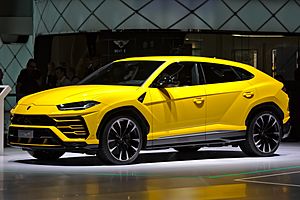
In 2019, a report showed that the number of SUVs and crossovers on the road worldwide had grown six times since 2010. They made up 40% of all new light vehicles sold globally.
By 2013, small and compact SUVs became the third-largest car market segment. Car makers kept introducing new versions to attract more buyers, including crossovers and other small SUVs. Larger SUVs also remained popular.
In 2015, global sales of SUVs became the largest car market segment, making up 22.9% of "light vehicle" sales. The next year, SUV sales grew even more by 22%. By 2017, they were 36.8% of the global passenger car market.
In the U.S., by the end of 2016, SUV and light-duty truck sales were much higher than traditional car sales. Car companies continued to stop making sedan models and replaced them with new SUV models.
Many luxury brands also started making SUV or crossover models in the 2010s. Examples include the Rolls-Royce Cullinan, Bentley Bentayga, and Lamborghini Urus.
By 2019, SUVs made up almost half (47.4%) of all car sales in the U.S.
SUVs in racing
SUVs have taken part in many off-road racing events. These include famous races like the Dakar Rally, the Baja 1000, and the FIA Cross-Country Rally World Cup. SUVs have also competed in ice-racing series like the Trophee Andros.
Nicknames for SUVs
Sometimes, people use funny or critical nicknames for SUVs, especially expensive ones from luxury brands. These names often combine a rich suburb's name with "tractor." For example, "Toorak Tractor" in Australia, "Chelsea Tractor" in London, England, and "Remuera Tractor" in New Zealand. These nicknames suggest that the owners don't really need the off-road abilities and buy the SUV more as a status symbol.
In Norway, a similar term is "Børstraktor," which means 'Stock Exchange Tractor.' In the Netherlands, SUVs are sometimes called "P.C. Hooft-tractors," named after a fancy shopping street in Amsterdam.
Commercial SUVs
A commercial SUV is an SUV or crossover that is used for business purposes. This is similar to panel trucks, which were often used for commercial work.
The first SUV-like vehicle that had commercial versions was the Chevrolet Suburban panel truck. These panel trucks were made by American companies until the late 1970s.
While commercial panel trucks were rare in Europe, commercial versions of off-road vehicles were very common there. For example, Land Rover made commercial versions of the Land Rover and the Defender. Commercial SUVs are built in factories and can be bought from dealerships.
Examples of SUVs used for commercial purposes in Europe include the Citroen C5 Aircross Commercial SUV, the Land Rover Discovery, and the Mitsubishi Pajero.
See also
 In Spanish: Vehículo utilitario deportivo para niños
In Spanish: Vehículo utilitario deportivo para niños
- Criticism of sport utility vehicles
- Four-wheel drive
- Off-road vehicle
- List of sport utility vehicles
- Recreational vehicle
- Crossover city car (A-segment SUV)
Images for kids
-
The Ford Bronco, an off-road mid-size SUV
-
The Cadillac Escalade, a full-size luxury SUV
-
The GMC Yukon XL, an extended-length SUV
-
A 1935–1940 Chevrolet Suburban
-
A 1994–2001 Ford Explorer


